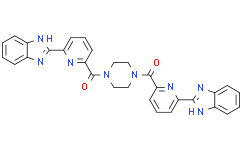| Cas No.: | 1912399-75-7 |
| Chemical Name: | Methanone, 1,1'-(1,4-piperazinediyl)bis(1-(6-(1H-benzimidazol-2-yl)-2-pyridinyl)- |
| Synonyms: | BT-11;A4Y49H6YY8;BT11;GTPL10363;BCP32788;BT 11; BT11;Example 1 [US9556146B2];s6419;analogue 7 [PMID: 27933891];SB18706;J3.612.231E;Methanone, 1,1'-(1,4-piperazinediyl)bis(1-(6-(1H-benzimidazol-2-yl)-2-pyridinyl)-;Piperazine-1,4-diylbis((6-(1H-benzo[d]imidazol-2-yl)pyridin-2-yl)methanone);[4-[6-(1H-benzimidazol-2-yl)pyridine-2-carbonyl]piperazin-1-yl]-[6-(1H-benzimidazol-2-yl)pyridin-2-yl]methanone |
| SMILES: | O=C(C1=C([H])C([H])=C([H])C(C2=NC3=C([H])C([H])=C([H])C([H])=C3N2[H])=N1)N1C([H])([H])C([H])([H])N(C(C2=C([H])C([H])=C([H])C(C3=NC4=C([H])C([H])=C([H])C([H])=C4N3[H])=N2)=O)C([H])([H])C1([H])[H] |
| Formula: | C30N8O2H24 |
| M.Wt: | 528.564 |
| Purity: | >98% |
| Sotrage: | 2 years -20°C Powder, 2 weeks 4°C in DMSO, 6 months -80°C in DMSO |
| Description: | BT-11 is an orally available LANCL2 binding compound for treating inflammatory bowel disease. |
| In Vivo: | The oral treatment with BT-11 (8 mg/kg/d) in a mouse model of inflammatory bowel disease results in lowering the disease activity index, decreasing colonic inflammatory lesions by 4-fold, and suppressing inflammatory markers (e.g., TNF-α, and interferon-γ) in the gut. Furthermore, studies in LANCL2−/− mice demonstrates that loss of LANCL2 abrogates beneficial actions of BT-11, suggesting high selectivity for the target. Oral treatment with BT-11 (8 mg/kg/day) ameliorates colitis in mice. Initial safety assessment in rats indicates that oral treatment with BT-11 at high doses has an excellent safety profile up to 1000 mg/kg/day[1]. BT-11 is well tolerated in rats, and may hold promise as an orally active therapeutic for Crohn’s disease. One hour after oral administration of a single dose of 80 mg/kg, BT-11 has a maximal concentration of 21 ng/mL; the half-life is 3 hours[2]. |
| In Vitro: | LANCL2 engagement produces an increase of PKA, followed by an accumulation of cAMP in the cytoplasm. BT-11 treatment splenocytes shows a dose−response increase of cAMP production. BT-11 stimulates cAMP production by activating the LANCL2 pathway[1]. |
| Animal Administration: | Rats: Male Harlan Sprague Dawley rats are treated with a single oral dose of 500 mg/kg and 80 mg/kg/d for 14 days. Treated and control rats are observed for behavioral detriments, and blood and tissues are collected for clinical pathology and histopathological examination[2]. Mice: Wild type and LANCL2−/− male mice are treated with 8 mg/kg/d BT-11 over 8 weeks. Mice are sacrificed and spleens are collected for splenocytes isolation. Cell lysates are collected and cAMP intracellular concentration is measured[1]. |
| References: | [1]. Carbo A, et al. An N,N-Bis(benzimidazolylpicolinoyl)piperazine (BT-11): A Novel Lanthionine Synthetase C-Like 2-Based Therapeutic for Inflammatory Bowel Disease. J Med Chem. 2016 Nov 23;59(22):10113-10126. [2]. Bissel P, et al. Exploratory Studies With BT-11: A Proposed Orally Active Therapeutic for Crohn's Disease. Int J Toxicol. 2016 Sep;35(5):521-9. |

 DC Chemicals' products qualify for U.S. tariff exemptions. We guarantee no price increases due to customs duties and maintain stable supply, continuing to deliver reliable research solutions to our American clients.
DC Chemicals' products qualify for U.S. tariff exemptions. We guarantee no price increases due to customs duties and maintain stable supply, continuing to deliver reliable research solutions to our American clients.





















